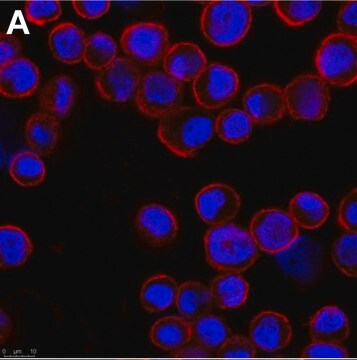Spécificité
Clone HL2476 is a mouse monoclonal antibody that detects Adeno-associated virus 5. It binds to binds to the 3-fold protrusions in the capsid protein.
Immunogène
Recombinant Adeno-associated virus 5 (AAV5) virus-like particles.
Application
Quality Control TestingEvaluated by Dot Blot in AAV5, AAV8, and AAV9 virus like particles (VLPs).Dot Blot Specificity Analysis: 10 ng of this antibody detected Adenovirus 5, but not AV8 and AAV9 virus like particles (VLPs).Tested ApplicationsNeutralizing Analysis: A representative lot neutralized Adeno-associated virus serotype 5 in Neutralizing applications (Jose, A., et. al. (2018). J Virol. 93(1):e01394-18). ELISA Analysis: A representative lot detected Adeno-associated virus serotype 5 in ELISA applications (Jose, A., et. al. (2018). J Virol. 93(1):e01394-18).Dot Blot Analysis: A representative lot detected Adeno-associated virus serotype 5 in Dot Blot applications.(Jose, A., et. al. (2018). J Virol. 93(1):e01394-18). Note: Actual optimal working dilutions must be determined by end user as specimens, and experimental conditions may vary with the end user
This mouse monoclonal Anti-Adeno-associated virus 5, clone HL2476, Cat. No. MABF2768 is tested for use in Dot Blot, ELISA and Neutralizing, for the detection of Adeno-associated viruses serotype 5.
Description de la cible
Adeno-associated viruses (AAV) are small, non-enveloped, non-pathogenic viruses that package a linear single-stranded DNA genome. AAV belong to the family Parvoviridae and productive infection by AAV occurs only in the presence of a helper virus, which could either be adenovirus or herpesvirus. AAV are recognized by glycosylated cell surface receptors of the host cell. This triggers internalization of the virus via clathrin-mediated endocytosis and then AAV traffic through the cytosol mediated by the cytoskeletal network. After successful infection, two stages of AAV life cycle have been described - a lytic stage and a lysogenic stage. In the presence of helper virus, the lytic stage ensues and during this period, AAV undergoes productive infection with genome replication, viral gene expression, and virion production. The lysogenic stage is established in host cells in the absence of a helper virus and AAV integrates into the host genome at specific site that contains a Rep binding element. AAV serotype 5 (AAV5) is one of the most divergent of the AAVs and it utilizes 2,3-linked sialic acid-containing glycans as primary host cell receptors. The virus capsids are assembled from 60 subunits of three overlapping capsid viral proteins: VP1; VP2; and VP3 in a 1:1:10 ratio. The individual VPs are expressed within the same open reading frame and share a C terminus. VP1 and VP2 represent N-terminal extended forms of VP3. Clone HL2476 is reported to bind to the 3-fold capsid region and exhibits high specificity of AAV5. Arginine 483 is reported to be the most critical contact residue for its binding. (Ref.: Jose, A., et al. (2019). J. Virol. 93(1); e01394-18; Wang, D., et al. (2019). Nat. Rev. Drug. Dis. 18(5); 358-378).
Forme physique
Purified mouse monoclonal antibody IgG2b in PBS without azide.
Stockage et stabilité
Stable for 1 year at -10°C to -25°C from date of receipt. Handling Recommendations: Upon receipt and prior to removing the cap, centrifuge the vial and gently mix the solution. Aliquot into microcentrifuge tubes and store at -20°C. Avoid repeated freeze/thaw cycles, which may damage IgG and affect product performance.
Autres remarques
Concentration: Please refer to the Certificate of Analysis for the lot-specific concentration.
Clause de non-responsabilité
Unless otherwise stated in our catalog or other company documentation accompanying the product(s), our products are intended for research use only and are not to be used for any other purpose, which includes but is not limited to, unauthorized commercial uses, in vitro diagnostic uses, ex vivo or in vivo therapeutic uses or any type of consumption or application to humans or animals.









